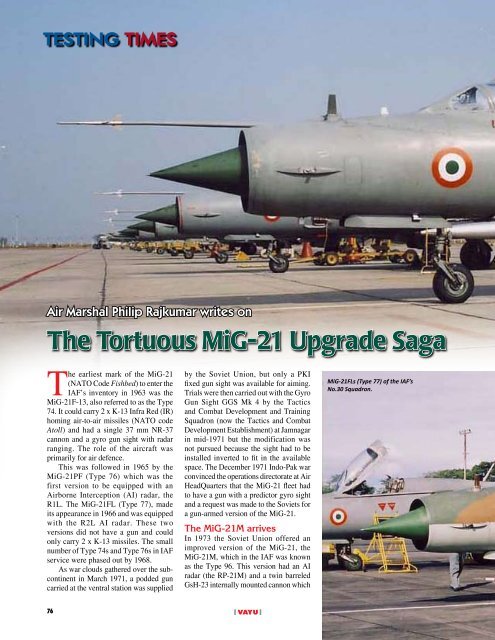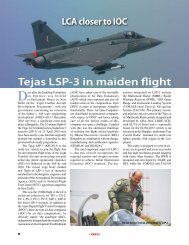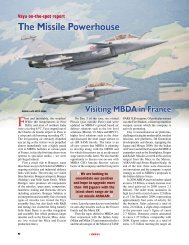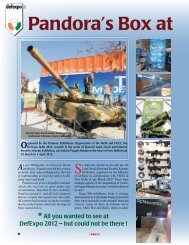The Tortuous MiG-21 Upgrade Saga - Vayu Aerospace
The Tortuous MiG-21 Upgrade Saga - Vayu Aerospace
The Tortuous MiG-21 Upgrade Saga - Vayu Aerospace
You also want an ePaper? Increase the reach of your titles
YUMPU automatically turns print PDFs into web optimized ePapers that Google loves.
could fire 3000 x 23 mm rounds perminute and had a gyro gun sight as well.In addition, this was equipped with animproved ejection seat (the KM-1) whichhad ground level ejection capability. <strong>The</strong>Soviets offered this version with a newengine, the R-13-300, which had somewhatmore thrust than the earlier R-11F2S-300engine which powered the Type 77 fleet.<strong>The</strong> airframe could accommodate theR-11 engine as well, but the R-13 enginehad a second stage afterburner which cutin at Mach 1.6 to improve supersonicacceleration. However, a large saddletank spoilt the beautiful area ruling of theType 77 airframe and the Type 96 couldnot match the supersonic performance ofthe Type 77. <strong>The</strong> Type 96 however, hada gun, a radar warning receiver, couldcarry 2 x 490 litre drop tanks under thewing, an 800 litre drop tank at the ventralstation and was therefore a more versatileplatform.As licence manufacture of the <strong>MiG</strong>-<strong>21</strong>M was contemplated, the IAF had toquickly decide on choice of the engine. InFebruary 1973 two <strong>MiG</strong>-<strong>21</strong>M aircraft, onefitted with a R-13 engine and designatedthe <strong>MiG</strong>-<strong>21</strong>MF (C-1533) and the otherfitted with the earlier R-11 engine,remained as the <strong>MiG</strong>-<strong>21</strong>M (C-1531),both positioned at ASTE at Kanpur. SqnLdr S Krishnaswamy (later CAS) and Icarried out a comparative evaluation ofperformance of the two aircraft with thetwo different engines between 22 Februaryand 4 March 1973.<strong>The</strong> evaluation consisted of 24operational profiles flown at low, mediumand high altitude. Acceleration timesto various Mach numbers, up to Mach2.05 and time to climb to 19 km werecompared. On 4 March 1973, I worepressure clothing and flew two static climbI/20127776-81 Testing Times.indd 77 6/8/2012 5:41:31 PM
<strong>MiG</strong>-<strong>21</strong>M (Type 96) at HAL Ozar.sorties to 19 km on the two aircraft oneimmediately after the other. <strong>The</strong> visibilitywas barely 1.5 km at Kanpur because ofdust haze and the radar surveillance by theradar unit at Memora, near Lucknow wasnot very good. I had to go out about 180km in a south easterly direction, accelerateto Mach 1.85 in the turn on to reciprocalheading and then climb to 19 km. On eachoccasion I reached 19 km with the 450litres low fuel level warning light glowingin the cockpit while I was still at a distanceof 100 km from base. <strong>The</strong> prevailingpoor visibility, pressure clothing whichrestricted outside view from the cockpit,the absence of navigation aids other thanthe radio compass and the low fuel statecalled for careful handling of the situation.I had to throttle back to idle below 15km altitude, descend at 500 km/hr IAS,arrive overhead base with just 300 litreswhich gave me three to four minutes toexecute the circuit and landing. It wassatisfying to complete the static climbs.<strong>The</strong> R-13 engine did give the MF versiona small but noticeable edge in performanceover the M version at low and mediumaltitude. Since the R-11 was alreadybeing manufactured at HAL, Koraput AirHeadQuarters decided to drop the R-13 ontechno-economic considerations.<strong>The</strong> Soviets did not give up efforts toconvince Air HeadQuarters to producethe R-13 instead of the R-11 at Koraputand offered an improved version of theR-13, the R-13F for evaluation by IAF testpilots. In April 1975, Air HeadQuarterssent a team of three officers, Wg Cdr PM‘Ramu’ Ramachandran (later VCAS), SqnLdr BR Madhav Rao, an AE(M) officerwho had vast experience of working onthe <strong>MiG</strong>-<strong>21</strong> and myself to Krasnodar, nearthe Black Sea to carry out the evaluation.<strong>The</strong> R-13F engine was identical to theR-13 except that it had the provision foran emergency reheat mode which couldbe engaged when required by turningon a switch which was just ahead of thethrottle. At Krasnodar we were not allowedto exceed 1000 km/hr IAS in the localflying area. Ramu and I could not find anydifference in performance in the sub sonicregime. When we discussed our findingswith the Soviets, they turned around andsaid that the main advantage could onlybe seen while accelerating to limitingIAS at low level or while acceleratingthrough the transonic regime at mediumaltitude. When asked to be allowed to gosupersonic at Krasnodar, they refused,saying that the area where they carriedout supersonic flights, foreigners werenot allowed to fly! We returned to AirHeadQuarters and categorically stated inour report that it was not worth going infor the R-13 F.Our rejection of the R-13F engine hada very beneficial effect because when theCAS, Air Chief Marshal OP Mehra, visitedthe Soviet Union a little later, his team wasshown the definitive <strong>MiG</strong>-<strong>21</strong>bis, fitted withthe R-25 engine. <strong>The</strong> R-25 was a muchsuperior engine to various engines fittedin <strong>MiG</strong>-<strong>21</strong>s so far in IAF service and the<strong>MiG</strong>-<strong>21</strong>bis entered service in 1976, beingmore capable than the M version becauseit had a superior AI radar, the Almaz, and abetter engine. Both the airframe and enginewere to be manufactured under license laterby HAL.In 1983 Air Marshal LM Katre wasappointed Chairman of HAL. He set abouttrying to revive the moribund design bureauof the company. He ordered the HPT-32to be re-engined with a turbo-prop, theHindustan Turbo Trainer-34 (HTT-34). Ihad an opportunity to fly some sorties on thisvery lively aircraft, which had impressiveperformance, spun exactly like the HPT-32and would have made an ideal trainer forthe basic flying stage in the IAF. Had thisaircraft development been pursued we wouldnot now have had to go to the world marketto look for a HPT-32 replacement. <strong>The</strong> Ajeettrainer project was given the go ahead anda <strong>MiG</strong>-<strong>21</strong>bis modernisation project waslaunched at HAL, Nasik. Air Marshal LM<strong>The</strong> first upgraded <strong>MiG</strong>-<strong>21</strong> bis (‘Bison’) in Russia.78 VAYU76-81 Testing Times.indd 78 6/8/2012 5:41:31 PM
Katre was a visionary Chairman and HALhad an opportunity to dramatically transformitself under his leadership but regrettably,his tenure at HAL (and later as CAS) wasall too short.Dr Kota Harinarayana who was theChief Resident Engineer (CRE) at Nasikjoined HAL and was made chief designerof the Nasik Design Bureau. One <strong>MiG</strong>-<strong>21</strong>bis airframe (C-2270) was modifiedwith the following modifications:<strong>The</strong> leading edge of the wingwas fitted with a vortex plate.This was no more than a steelplate with a rounded contour tofit the leading edge with a metalplate about six centimeters inlength which protruded from thebottom of the leading edge intothe airstream. This device was amodification developed by theNational <strong>Aerospace</strong> Laboratories(NAL) after extensive wind tunnelwork at Bangalore and meant toenergise the airflow over the wingsat high angles of attack therebyimproving turn performance.<strong>The</strong> normal two position wingflap was replaced by a blow backflap which extended in stages asthe speed reduced. It retractedfully at about 700km/hr IAS. Thisdevice was also meant to improvemanoeuvere performance at lowspeeds.An enlarged saddle tank whichincreased fuel capacity by 200litres was fitted. This modificationcertainly made the dorsal spinebehind the cockpit look fat andugly!Some Soviet era avionics likethe radio, radio compass, radioaltimeter were replaced byWestern avionics. To make useof the savings in weight a smallrubberised fuel tank containing120 litres of fuel was fitted inthe area behind cockpit pressurebulkhead.After initial flights at Nasik, theaircraft was positioned at ASTE in early1985 for a thorough evaluation. I wasthe Chief Test Pilot at ASTE at that timeand the evaluation was done by pilotsin the Flight Test Squadron. I flew onlyone sortie on 14 June 1985, to look atthe problem areas pointed out by theevaluation pilots. <strong>The</strong> vortex plate didimprove subsonic turn rates by about 8-10% which was good for a passive, low costdevice. Supersonic acceleration, however,deteriorated due to the fat saddle tankand the combat flap did not significantlyimprove manoeuvere performance. AirHeadQuarters rejected this attempt atmodernisation but this was, however, agood learning experience for the Nasikdesign bureau.<strong>MiG</strong>-<strong>21</strong>bis in camouflage paint over thePunjab (photo by Air Marshal MM Singh).One of the principal drawback ofvarious marks of the <strong>MiG</strong>-<strong>21</strong>s in IAFservice was the absence of a navigationand attack system. Navigating at lowlevel with only a stop watch, compassand map required a lot of training andpractice to attain and retain proficiency.Weapons could be delivered accurately ina dive only by adhering to rigid entry andrelease conditions which did not allow forany tactical flexibility in the attack. Laydown attacks with retarded weapons wereequally difficult because the target woulddisappear below the nose well before therelease point. <strong>The</strong> final release had to bedone by counting down a time delay afterthe target had disappeared! This methodwas not very accurate and so by 1986the IAF had started serious search for asuitable navigation and attack system forits <strong>MiG</strong>-<strong>21</strong> fleet.Evaluation in EgyptIn 1987, Marconi Elliot of the UKinformed Air HeadQuarters that they hadfitted a nav/attack system in <strong>MiG</strong>-<strong>21</strong>Msof the Egyptian Air Force (EAF). <strong>The</strong>system consisted of a Head Up Display<strong>MiG</strong>-<strong>21</strong> bison in frontline service.I/20127976-81 Testing Times.indd 79 6/8/2012 5:41:32 PM
(HUD), a display processor which also didweapon aiming computations and an airdata computer which accepted inputs fromthe aircraft’s pitot static system and twingyro platform to perform navigationcalculations. A colour video camerawhich recorded HUD symbology toact as a useful mission debrief tooland a keyboard fitted just below theHUD which was the input device,completed the system. Apart fromthe HUD, keyboard and camerawhich were fitted in the cockpitthe rest of the system was neatlypackaged in nose compartment ofthe aircraft.Thanks to good relations existingbetween the UK, India and Egypt, thecompany offered to arrange for a nocost - no commitment evaluation of theirsystem fitted in an EAF aircraft. <strong>The</strong> EAFEgyptian Air Force R&D Department StickerHeadQuarters to attach me to an operationalsquadron for a short while to get my handback and practice weapon delivery. Iflew seven armament sorties with No. 29Squadron at Jamnagarbetween 4 and 7 August1987. I really enjoyedmyself firing rockets andguns and dropping practicebombs over Sarmat rangeafter a long break!<strong>The</strong> evaluation was conducted atthe Al Mansoura air base in the Niledelta, north of Cairo between 24 and29 August 1987. I was first briefed onthe system characteristics by MarconiElliot representatives and the EAFResearch and Development departmentpersonnel. I familiarised myself withthe system in a system simulator on theground and was first given a sector recceIAF team in front of ‘Monument to Aviation’ at Krasnodar Air Base, USSR, April 1975. Sqn. Ldr. B.R. Madhav Rao is 3rd from left,Wg.Cdr. P.M. Ramachandran is 5th from left and Sqn. Ldr. P. Rajkumar is 7th from left.wanted their aircraft to be insured andthe insurance company in turn wanted toknow the qualifications and experienceon type of the pilot who would performthe evaluation. Air HeadQuarters detailedme to do the evaluation and the insurancecompany accepted my competence to dothe job as I had flown over 2000 hourson various marks of the <strong>MiG</strong>-<strong>21</strong> by thattime!As I was not in regular flying touchwith the <strong>MiG</strong>-<strong>21</strong>M, I requested Airsortie in a <strong>MiG</strong> trainer by Colonel Ibrahimof the EAF. <strong>The</strong> early morning haze overthe delta was dense and visibility wasbarely a couple of kilometers. Whenwe reached Port Said and started flyingwestwards towards Alexandria over the80 VAYU76-81 Testing Times.indd 80 6/8/2012 5:41:54 PM
Mediterranean Sea, the visibility improvedconsiderably. Colonel Ibrahim said hewould send a chase aircraft when I flewsolo and I agreed because the triangularcross country way points were small townsin the delta and it would have been easyto miss them in the haze. In all I flew foursorties (tail nos 8354 and 8324) to assessnavigation performance and did dummydives over the airfield to prepare for theweapon delivery sorties. Unfortunatelythe EAF got cold feet at this stage anddid not authorise me for weapon deliverysaying that the Wadi Natrun range in thedesert west of Cairo was“not available”. One ortwo sorties of weapondelivery would not haveenabled me to collect anystatistically significantdata and EAF statisticswould have had to beused in any assessment.In my view the lack oflive firing did not affectthe evaluation.After having flown theinertial nav/attack systemin the Darin Jaguars, Ithought this system onoffer was primitive. It mayhave been state of the artsome years earlier but itwas clearly out of date. Idid, however, find flying the <strong>MiG</strong>-<strong>21</strong> witha HUD a pleasure and the video recorderdebriefing tool of immense value. AirHeadQuarters now gave up its search fora nav/attack system for the time being.<strong>The</strong> Need forComprehensive <strong>Upgrade</strong>When AOC, AF Station Gorakhpur in1989, I was sent on a short course onSystems Analyses at Metcalfe Housein old Delhi. I found this course veryinformative and useful because it taughtone how to develop quantitative criteriato aid decision making. In 1991 when Iwas Commandant ASTE I was asked byAir HeadQuarters to carry out a study onoperational effectiveness between Sovietoriginand Western aircraft. Amongstother things this study clearly brought outthe need to upgrade as many systems inan aircraft as possible if its effectivenesswas to be improved. To meaningfullyupgrade the <strong>MiG</strong>-<strong>21</strong> fleet, a number ofimprovements had to be made in onego particularly pertaining to its primarysensor, the AI radar, and then navigation,weapons, weapon aiming systems plusairframe life extension which was requiredfor reasonable exploitation of the upgradedfleet.<strong>The</strong> Soviet Union had passed intohistory at the end of 1991 and now theRussian Federation offered an upgradepackage for the <strong>MiG</strong>-<strong>21</strong>bis fleet in 1992.At about the same time, India establisheddiplomatic relations with Israel and defenceties with that country started to develop at aDuring <strong>MiG</strong>-<strong>21</strong> <strong>Upgrade</strong> talks in Moscow, December 1993 : at the Mikoyan Design Bureau.In front of bust of Artem Mikoyan, famed founder of the <strong>MiG</strong> Design Bureau are (left to right)Flt. Lt. Chatterjee,, unknown, Wg.Cdr. Sethi, Gp. Capt.H. Masand, RA Beliakov, Head of DesignBureau, Air Cmde P.Rajkumar, Manucharov Rawal, Dy GM, HAL, Nasik.rapid pace. Israel Aircraft Industries (IAI)offered an upgrade of the <strong>MiG</strong>-<strong>21</strong>, whichthey had developed for the RomanianAir Force. In May 1993 I was sent to TelAviv to evaluate this proposal. <strong>The</strong> firsttopic I raised with the IAI engineers wasabout airframe life extension. When askedwhether they had the structural data ofthe <strong>MiG</strong>-<strong>21</strong>bis airframe to carry out thelife extension they replied in the negativeand said they expected the IAF to providesuch data. I then flew a sortie in a Lavi testbed aircraft to evaluate the Elta 2032 radarwhich was being offered for the upgrade.Unfortunately the radar failed after only10 minutes of flight and I was not able toevaluate it. When I submitted my reportto Air HeadQuarters stating these twoimportant factors, the Israeli proposal wasrejected.In July 1993 I was posted to AirHeadQuarters as Director Air StaffRequirements and the <strong>MiG</strong>-<strong>21</strong> fleetupgrade problem dropped into my lap. <strong>The</strong>Mikoyan design bureau had offered a veryattractive upgrade package at reasonablecost. <strong>The</strong> package consisted of a new radarcalled the Kopyo, Beyond Visual Range(BVR) missile carrying capability, latestClose Combat Missiles, an Inertial Nav/Attack System (INAS), Counter MeasuresDispensing System (CMDS) and some EWcapability. In December 1993, I led a teamof IAF, HAL and DRDO officers for a firstround of talks on the upgrade proposalwith the Mikoyan design bureau and hadthe pleasure of interacting with Mr RABeliakov who was Chief Designer of thebureau. I had a groupphotograph takenof the team and himstanding near the bustof Artem Mikoyan,the famous designerwho had founded thedesign bureau. <strong>The</strong>Indian team visitedseveral other plantswhere other systemson offer were beingmanufactured. Ofparticular interest wasthe team’s visit to theVympel missile designbureau at Tushino andthe Sokol plant atNizhny Novogorod(old name Gorkhy)dedicated to the manufacture of <strong>MiG</strong>designs. This was the plant whereupgradation of the first two airframeswould be carried out. We spent twoweeks in the freezing cold of Moscowbut returned to Delhi convinced that theRussian package was the manner to go.In July 1994, I led another team for thesecond round of talks and we were ableto finalise the technical specifications ofthe upgrade. Commercial negotiationsfollowed and the contract was signedsometime in 1996.<strong>The</strong> IAF positioned a team of testpilots and technical officers at theSokol plant at Nizhny to oversee theupgrade programme. Wing CommanderN Harish was the first IAF test pilot tofly the upgraded Mig-<strong>21</strong>bis now calledthe Bison (son of Bis!) in 2000. <strong>MiG</strong>-<strong>21</strong>Bison squadrons are now in operationalservice and so the long and tortuousupgrade saga of the <strong>MiG</strong>-<strong>21</strong> recorded itsfinal chapter.I/20128176-81 Testing Times.indd 81 6/8/2012 5:41:56 PM








